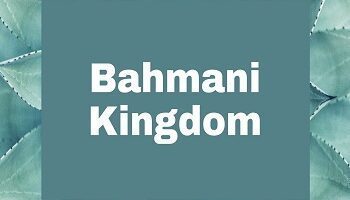Table of Contents
Harappan Civilization:
Till the beginning of the twentieth century, historians were not aware of the existence of an ancient civilization in north-western India. In 1921, an Indian archaeologist, working for the Archaeological Survey of India, Dayaram Sahni, discovered the ancient ruins of Harappa on the banks of the River Ravi, in the province of West Punjab, now in Pakistan. A year later in 1922, Rakhaldas Banerjee, another officer of the Archaeological Survey of India, discovered the city of Mohenjodaro (mound of the dead) in the Larkana district of Sind (now in Pakistan). The excavations at the two sites revealed the existence of a well-planned civilization. These two sites were 483 km apart and were linked through the River Indus.
The civilization came to be known as the Harappan Civilization because Harappa was the first city to be discovered in the Montgomery District (Pakistan). It is also known as the Indus Valley Civilization, as it was discovered on the banks of the River Indus and its tributaries. This civilization belonged to the Chalcolithic Age and flourished during 2500-1500 B.C.
Extent of the Harappan Civilization:
Excavations have revealed that the Harappan Civilization was spread over a very wide area. It covered parts of Punjab, Sind, Baluchistan, Gujarat, Rajasthan, and the fringes of western Uttar Pradesh. It extended from Jammu in the north to the Narmada estuary in the south and from the Makran coast of Baluchistan in the west to Meerut (Alamgirpur) in the northeast.
Although more than 100 Harappan sites are known, some of the most interesting and important Harappan sites are Harappa, Mohenjodaro, Chanhudaro (along the Indus River in Sindh), Kalibangan (on Ghaggar River in Rajasthan), Banawali (in Hissar district of Haryana) and Lothal (a port town in Gujarat). Evidence of the Harappan culture is also found in the coastal cities of Sutkagendor (on the River Dashk in Baluchistan), and Surkotada (in Gujarat). The most recently excavated sites are Dholavira (in Gujarat), Rakhigarhi (in Haryana), and Mithathal (in Haryana).
Characteristics of the Harappan Civilization:
The Harappan Civilization was characterized by certain unique features that set it apart from all the other cultures of the time. For example, at almost every site, archaeologists have found evidence of town planning and drainage system. Let us take a look at some of the features of the Harappan Civilization.
Town Planning:
The Harappan Civilization was urban in nature. The first thing that strikes us is the town planning. The two cities, Mohenjodaro and Harappa, were built on a similar plan.
(1) To the west of each city was a citadel built on a high platform. On it, public buildings like religious structures and granaries were erected. The ruler and the ruling class, consisting of rich merchants and priests probably lived here. The citadel was defended by a wall, possibly to protect it against floods or enemy attacks. Below the citadel, lay a lower town containing brick houses that were inhabited by common people.
(2) The streets of the Harappan cities followed the grid system i.e. the main streets ran from north to south and other streets ran at right angles to the main street. The streets thus divided the city into square or rectangular blocks.
(3) The streets were rounded off to allow the carts to turn easily.
(4) Houses stood on both sides of the streets. This way they did not encroach on the streets.
(5) Both at Harappa and Mohenjodaro, houses were built of kiln-burnt bricks. At Lothal and Kalibangan, houses were made of sun-dried bricks.
(6) An average house had, besides the kitchen and the bath, four to six living rooms. Large houses with staircases suggest the existence of two or three-storeyed buildings.
(7) Most of the houses had a well. The houses were equipped with drains that carried the waste to the main underground drain of the street. There were also public baths with wells.
(8) There was also an arrangement for street lighting.
Drainage System:
Perhaps the most unique feature of the Harappan Civilization was the efficient and well-planned drainage system.
(1) The kitchen and bathroom had sloping floors to allow the water to drain out into the narrow drains alongside.
(2) The house drains were connected to the main underground drains, which carried the waste to the large pits outside the city.
(3) The street drains ran along the sides of the street. They were covered with bricks. They had soak pits and manholes for clearing.
The extreme importance given to the drainage system shows that the Harappans paid great attention to sanitation and hygiene.
Important Buildings:
One of the largest buildings so far discovered in the Harappan cities and the most important public place at Mohenjodaro is the Great Bath. It comprises of a tank made of bricks. There are six entrances to the Great Bath. At the north and south ends of the Great Bath, brick steps lead to the bottom of the tank that could be emptied by a drain. The Great Bath was possibly meant for some elaborate ritual of great importance for the people.
To the west of the Great Bath, there lay a large granary. It was used for storing surplus food grain. A Great Granary (largest building) was found at Mohenjodaro while six small granaries were found at Harappa. Towards the south of the granary, there are circular working platforms. These were probably used for threshing grain. We also find several furnaces in the Great Granary, which may have been used by metal workers to produce a variety of metal objects.
At Mohenjodaro, we find another building called the Assembly Hall. It is a pillared hall with twenty square brick pillars arranged in four rows. This hall may have been the assembly hall for collective prayers by the people of the city.
A brick dockyard connected to the Gulf of Cambay by a channel has been discovered at Lothal. It shows that the Harappans were engaged in maritime trade with West Asia. Hundreds of seals belonging to the Persian Gulf region indicate that Lotha was a major port of exit and entry.
Agriculture:
Like the Egyptian and Mesopotamian civilizations, agriculture was the main occupation of the Hrappans. The Harappans cultivated on the banks of the river were made fertile by silt-bearing floods. They sowed seeds in the flood plains in November, when the flood water receded, and reaped their harvests in April before the advent of the next flood. Wheat and barley were the main food grains. Dates, field peas, sesame, and mustard were grown. It seems that rice was also cultivated, as rice husks embedded in clay and pottery have been discovered at Lothal. A fragment of cotton cloth has been found at Mohenjodaro indicating that the Harappan people cultivated cotton.
Animal Husbandry:
The Harappan people domesticated oxen, buffaloes, goats, sheep and pigs. Cats and dogs were regarded as pets. Asses and camels were possibly used as beasts of burden. Remains of horse have been found in Surkotada. Elephants were well known. The humped bulls were favored by the Harappans.
Crafts and Industries:
The Harappan Civilization saw the growth of several new arts and crafts. A group of people emerged as specialists who polished beads, made seals, and so on.
Cloth-weaving industry and pottery-making seem to be significant. The Harappans were excellent potters. They used the potter’s wheel to skilfully make pottery of various shapes and sizes. The pots were painted with geometrical patterns and shapes.
Metal Work:
Copper and bronze were used for making vessels, ornaments, tools, and weapons. Great skill was employed in making the bronze figurines of human beings, animals, etc. The most striking of them is perhaps the bronze dancing girl, which exhibits great craftsmanship. Wearing a necklace and a series of bangles almost covering one arm, her hair is neatly arranged.
Gold and silver were used for making a variety of beads, pendants, armlets, brooches, needles, and other personal ornaments.
Seals:
About 2000 seals of varying sizes have been unearthed from various Harappan sites. They were usually made of terracotta, soapstone, steatite, and copper. These seals provide us with interesting and important information about the Harappan people. Some seals have representations of animal figures and an inscription on them. Most seals have figures of real animals. One depicts a humped bull of great strength. One of the most important seals, the so-called “Pashupati seal” discovered in Mohenjodaro, depicts a personage surrounded by animals- a rhinoceros, a buffalo, an elephant, and a tiger. The figure wears a crown made of a pair of horns and sits in a yogic posture. Some scholars have seen this depiction as the prototype of Shiva as Pashupati (the Lord of Animals). Others have pointed out that the Vedic Pashupati was the Lord of domesticated cattle, not of wild animals found in dense forests, and that the seal perhaps represents a holy person who could communicate with animals or who wielded some sort of power over them. Seals depicting a creature similar to the mythical unicorn with a single protruding horn have also been found.
The Importance of Seals- No completely satisfactory explanation can be provided regarding the use of seals. A large number of them have a hole, which suggests that they may have been worn around the neck or the arm as amulets. The exquisitely carved-out figures on the seals bear witness to the skill and workmanship of the artists. These figures tell us of the clothes, ornaments, and hairstyles worn by the Harappan people. They also throw some light on the religious beliefs of the people. Seals excavated at the Indus sites show that the people may have worshipped trees and animals. The inscriptions on the seals bear testimony to the fact that the people were literate. Most importantly, the discovery of a large number of Harappan-style seals in West Asian sites like Mesopotamia proves that trade relations existed between the two regions.
Terracotta Models:
The Harappan people made brilliant terracotta models used either as toys or objects of worship. A number of terracotta female figurines have been found which may have been the symbol of the mother goddess.
Trade:
The Harappan traded both within the country, i.e. with south India (for the procurement of gold), and outside like Mesopotamia, Afghanistan, and Baluchistan.
Trading links with Mesopotamia have been proved by the discovery of Mesopotamian seals in the Harappan cities and those of Harappa in the cities of ancient Mesopotamia near Ur, Lagash, and Umma.
Literary sources and inscriptions from Mesopotamia allude to the Ur merchants purchasing timber, copper, beads of various kinds, and gold from ‘Meluha’. Scholars believe that this Meluha stands was the Indus region. Some of the main items of trade were lapis lazuli, turquoise, jade, and so on.
The discovery of weights and measures suggests that commercial exchanges were quite common. In fact, some of the weights are so small that they must have been used to weigh precious objects.
Trade thus brought about prosperity that saw the cities provide their citizens with the finest urban civilization.
Religion:
The Harappan Civilization is marked by an absence of religious structures. Yet we can form an idea about the religious life of the people through the various figurines and seals excavated.
The numerous female terracotta figurines suggest that the Harappans worshipped Mother Goddess, the early form of Shakti.
The Pashupati seal depicting the three-faced deity denotes the early conception of Shiva.
The discovery of fire altars in Kalibangan points to the performance of the fire ritual.
The Harappans also worshipped trees like pipal. It has been depicted variously- as a leaf decoration on pottery and as a tree on seals. From the finds of articles of daily use in the graves, it is supposed that the Harappans probably believed in life after death.
Harappan Script:
Like the people of ancient Mesopotamia, the Harappans invented the art of writing. It was a pictographic script, but unfortunately, it has not been deciphered so far. Therefore, we do not know much about their literary contribution. Mostly, the seals are the specimens of the Harappan Script.
Decline of the Harappan Civilization:
The Harappan Civilization came to an abrupt end. Several theories have been put forward by the scholars:
(1) The climatic change in the Indus region may have been responsible for the disappearance of the civilization.
(2) The use of kiln-burnt bricks must have required a lot of fuel. Excessive deforestation may have resulted in a decrease in rainfall and forced people to evacuate.
(3) Natural causes like floods may have led to the evacuation of Mohenjodaro.
(4) The invasion by the nomadic invaders in the second millennium BC may have broken up organized agriculture altogether. The presence of a walled city structure does indicate invasions and the coming of the Aryans.
Thus numerous causes, both natural and human, appear to have been responsible for the decline of the Harappan Civilization. Nevertheless, though the civilization ended dramatically it succeeded in transmitting its philosophy and religion to its successors.









Comments (No)